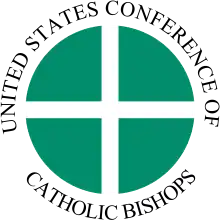Roman Catholic Archdiocese of Detroit
The Archdiocese of Detroit (Latin: Archidiœcesis Detroitensis) is a Latin Church ecclesiastical territory or archdiocese of the Catholic Church covering the Michigan counties of Lapeer, Macomb, Monroe, Oakland, St. Clair, and Wayne. It is the metropolitan archdiocese of the Ecclesiastical Province of Detroit, which includes all dioceses in the state of Michigan. In addition, in 2000 the archdiocese accepted pastoral responsibility[2] for the Catholic Church in the Cayman Islands, which consists of Saint Ignatius Parish[3] on Grand Cayman (the Archdiocese of Kingston maintains a mission sui iuris jurisdiction over the Cayman Islands).[4]
Archdiocese of Detroit Archidiœcesis Detroitensis | |
|---|---|
_-_exterior.JPG.webp) Cathedral of the Most Blessed Sacrament | |
| Location | |
| Country | |
| Territory | Counties of Lapeer, Macomb, Monroe, Oakland, St. Clair, and Wayne |
| Ecclesiastical province | Detroit |
| Statistics | |
| Area | 3,901 km2 (1,506 sq mi) |
| Population - Total - Catholics | (as of 2021) |
| Parishes | 224[1] |
| Information | |
| Denomination | Catholic |
| Sui iuris church | Latin Church |
| Rite | Roman Rite |
| Established | March 8, 1833 (190 years ago) |
| Cathedral | Cathedral of the Most Blessed Sacrament |
| Patron saint | St. Anne |
| Current leadership | |
| Pope | Francis |
| Archbishop | Allen Henry Vigneron |
| Auxiliary Bishops | |
| Vicar General | Jeff Day |
| Bishops emeritus | Adam Joseph Cardinal Maida Thomas Gumbleton Donald Hanchon Francis R. Reiss |
| Map | |
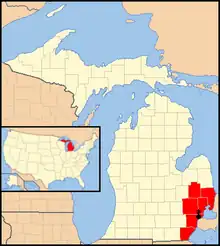 | |
| Website | |
| aod.org | |
Established as the Diocese of Detroit on March 8, 1833, it was elevated to archiepiscopal status on May 22, 1937. Ste. Anne's in Detroit is the second oldest continuously operating Catholic parish in the United States dating from July 26, 1701; it now serves a large Hispanic congregation.[5][6]
The Cathedral of the Most Blessed Sacrament, located at 9844 Woodward Avenue, in Detroit has served as the mother church since 1938. Earlier cathedrals were: Ste. Anne de Detroit, 1833 to 1848;[7] Sts. Peter and Paul Church, 1848 to 1877;[8] 1877 to 1890, St. Aloysius (as pro-cathedral), 1890 to 1938, St. Patrick's Church at 124 Adelaide Street.[9]
History

Before the Diocese of Detroit was formed, Michigan had been under the ecclesiastical jurisdiction of the Diocese of Quebec from 1701 until sometime after 1796; de facto American sovereignty was established in that year. At the time, the Diocese of Baltimore encompassed the whole of the United States. Upon the creation of diocesan seats at Bardstown (1808) and later, at Cincinnati (1821), Detroit and Michigan were assigned to those sees.
Pope Gregory XVI formed the Diocese of Detroit March 8, 1833, and named Frederick Rese as its first bishop. At the time it covered Michigan, Wisconsin, Minnesota and the Dakotas to the Missouri River. In 1843, all territory of the diocese not incorporated into the State of Michigan was transferred to the Diocese of Milwaukee.
On July 29, 1853, Pope Pius IX formed the Vicarate Apostolic of Upper Michigan, with responsibility for the Upper Peninsula. The territory of the diocese would be further reduced to its current size by the organization of the dioceses of Grand Rapids (1882), Lansing (1937), and shortly after the see was elevated to the status of an archdiocese, Saginaw (1938).[1]
The son of Prussian Polish immigrants, Rev. John A. Lemke, born in Detroit on February 10, 1866, was the first native-born Roman Catholic priest of Polish descent to be ordained in America. He was baptized at St. Mary Roman Catholic Church (1843), at the corner of St. Antoine and Croghan (Monroe Street), on February 18, 1866, attended St. Albertus for his primary education, and studied at Detroit College (now the University of Detroit Mercy), where he received a bachelor's degree in 1884. After attending St. Mary's in Baltimore, he completed his theological studies at St. Francis Seminary in Monroe, Michigan, and he was ordained by Bishop John Samuel Foley in 1889. His added confirmation name was Aloysius.[10]
In January 1989, Cardinal Edmund Szoka implemented a controversial plan to close 30 churches within the city of Detroit. He also ordered 25 other parishes to improve their situation or also face closure.[11] The plan resulted from a five-year study which analyzed maintenance costs, priest availability, parish income and membership before recommending closure of 43 parishes.[12]
The Association of Religion Data Archives indicated a Catholic membership in the archdiocese of 907,605.[13]

On May 5, 2011, Archbishop Allen Vigneron announced that Pope Benedict XVI approved his request to name Saint Anne as patroness of Detroit. The Papal decree stated that Saint Anne has been the city's patroness since time immemorial.[14]
On February 21, 2012, Vigneron announced a second plan to consolidate churches to address declining membership and clergy availability within the archdiocese. Under the plan, two parishes would close in 2012 and 60 others were to consolidate into 21 by the end of 2013. Six additional parishes were asked to submit a viable plan to repay debt or merge with other churches and the remaining 214 parishes in the archdiocese were asked to submit plans by the end of 2012 to share resources or merge.[15]
On June 3, 2017, the archdiocese adopted a new coat of arms featuring the archdiocesan patroness St. Anne, three stars representing the Trinity, a door representing Blessed Solanus Casey of Detroit, and waves representing the Great Lakes. It replaced a coat of arms featuring antlers and martlets that was adopted upon the diocese's elevation to an archdiocese in 1937.[16]
In 2014, the Archdiocese of Detroit began a missionary transformation with a Year of Prayer. During 2016, listening sessions were held at every parish to learn how the faithful felt the Archdiocese of Detroit could move from maintenance to mission. In November 2016, Archbishop Vigneron led a Synod during which over 400 participants – clergy, religious and laity – gathered to pray, share and discern a plan to renew the Church in Detroit.[17]
The fruit of those efforts was Archbishop Vigneron's pastoral letter, Unleash the Gospel, released on the Feast of Pentecost 2017. In this letter, Archbishop gave the roadmap for the missionary transformation of the Archdiocese of Detroit. This foundational document is the repository of the graces of Synod 16 that allows the work of the movement to unleash the Gospel to move forward with confidence, focus and resolve.[18]
Response to Clergy Sexual Abuse Crisis
The Archdiocese of Detroit first implemented its Policy on the Sexual Abuse of Minors by Clergy in 1988. The current, revised policy takes into consideration events and experiences of the past 30+ years, including The Charter for the Protection of Children and Young People (the Dallas Charter), which was enacted in 2002 by the United States Conference of Catholic Bishops (USCCB).
The Archdiocese of Detroit fully complies with the provisions of the Dallas Charter, including restricting the ministry of any priest against whom there is a “credible allegation” of the sexual abuse of a minor or vulnerable person, and the permanent removal from ministry of any priest subsequent to a determination of clerical sexual abuse by a canonical (Church law) process. Like all other U.S. dioceses, the Archdiocese of Detroit is subject to an independent compliance audit annually.
Another key provision of the Charter involves safe-environment training for all clerics serving in the Archdiocese of Detroit (including those who incardinate/transfer here or are in the area under different circumstances – e.g., as a student – and want to serve publicly in priestly ministry); priest candidates at Sacred Heart Major Seminary; as well as lay personnel, volunteers and students. Tens of thousands of individuals have been trained in the Archdiocese of Detroit over the past 17 years.
In 2002, a newly constituted Review Board was established to consider all reports of abuse and to advise the Archbishop. The Board is led by a retired Michigan Appeals Court Judge who was key in the drafting and adoption of the state's first Victim's Rights Act. Other individuals currently serving on the board include a retired prosecutor who established and led Wayne County's first dedicated child abuse unit; a child psychologist; a health care executive; a former superintendent of Catholic schools; and an archdiocesan pastor.
Pursuant to a 2002 agreement with the six Michigan county prosecutors within the Archdiocese of Detroit, every complaint received by the Archdiocese of Detroit is immediately turned over to civil authorities, regardless of its source or when the alleged abuse took place. No complaints are held back, pre-screened or disregarded. The Archdiocese fully cooperates with law enforcement.
Similarly, every complaint is considered by the Review Board. Regardless of what finding or course of action civil authorities may pursue, if a complaint is found by the Review Board to be credible, the priest or deacon is restricted from ministry pending further investigation and resolution of the matter. The Archdiocese considers a complaint to be credible if it has a “semblance of truth,” meaning the allegation seems to be neither manifestly false nor frivolous; it appears to be or could possibly be true. Complaints involving non-clerical personnel are processed pursuant to the Archdiocesan Code of Conduct. In 2019, a Vatican-mandated protocol was adopted in the United States for reporting allegations of sexual abuse by bishops.
In the Archdiocese of Detroit, no priest or deacon with a credible complaint against him is allowed to continue in active ministry during the time his case is under review by the Church or civil authorities. Those priests who are restricted and/or removed from ministry are monitored by a retired parole officer to ensure compliance with the strict limitations on their public ministry.[19]
Bishops
Bishops of Detroit
- Frederick Rese (1833–1871)
- Peter Paul Lefevere (coadjutor bishop 1841–1869); died before succession - Caspar Borgess (1871–1887)
- John Samuel Foley (1888–1918)
- Michael Gallagher (1918–1937)
Archbishops of Detroit
- Cardinal Edward Aloysius Mooney (1937–1958)
- Cardinal John Francis Dearden (1958–1980)
- Cardinal Edmund Casimir Szoka (1981–1990), appointed President of the Prefecture for the Economic Affairs of the Holy See and later President of the Pontifical Commission for Vatican City State and Governatorate of Vatican City State
- Cardinal Adam Joseph Maida (1990–2009)[20]
- Allen Henry Vigneron (2009–present)[21]
Current auxiliary bishops of Detroit
- Arturo Cepeda (2011–present)
- Gerard William Battersby (2016–present)
- Robert Joseph Fisher (2016–present)
- Paul Fitzpatrick Russell (2022–present), holds the title of Archbishop ad personam.[22][23]
- Jeffrey M. Monforton (2023-present)[24]
Former auxiliary bishops of Detroit
- Edward D. Kelly (1910–1919), appointed Bishop of Grand Rapids
- Joseph C. Plagens (1924–1935), appointed Bishop of Sault-Sainte Marie-Marquette
- Stephen Stanislaus Woznicki (1937–1950), appointed Bishop of Saginaw
- Allen James Babcock (1947–1954), appointed Bishop of Grand Rapids
- Alexander M. Zaleski (1950–1964), appointed Coadjutor Bishop of Lansing and subsequently succeeded to that see
- John Anthony Donovan (1954–1967), appointed Bishop of Toledo
- Henry Edmund Donnelly (1954–1967)
- Joseph M. Breitenbeck (1965–1969), appointed Bishop of Grand Rapids
- Walter Joseph Schoenherr (1968–1995)
- Thomas Gumbleton (1968–2006)
- Joseph Leopold Imesch (1973–1979), appointed Bishop of Joliet in Illinois
- Arthur Henry Krawczak (1973–1982)
- Dale Joseph Melczek (1982–1995), appointed Coadjutor Bishop of Gary, and subsequently succeeded to that see after collateral assignment as Apostolic Administrator of the Diocese of Gary (1992–1995)
- Patrick R. Cooney (1982–1989), appointed Bishop of Gaylord
- Moses Anderson, SSE (1982–2003)
- Bernard Joseph Harrington (1993–1998), appointed Bishop of Winona
- Kevin Michael Britt (1993–2002), appointed Coadjutor of Grand Rapids and subsequently succeeded to that see
- John Clayton Nienstedt (1996–2001), appointed Bishop of New Ulm
- Allen Henry Vigneron (1996-2003), appointed Coadjutor Bishop of Oakland and subsequently succeeded to that see; later appointed Archbishop of Detroit
- Leonard Paul Blair (1999–2003), appointed Bishop of Toledo
- Earl Boyea (2002–2008), appointed Bishop of Lansing
- John M. Quinn (2003–2008), appointed Coadjutor Bishop of Winona and subsequently succeeded to that see
- Francis R. Reiss (2003–2015)
- Walter A. Hurley (2003–2005), appointed Bishop of Grand Rapids
- Daniel E. Flores (2006–2009), appointed Bishop of Brownsville
- Michael J. Byrnes (2011–2016), appointed Coadjutor Archbishop of Agana (Guam) and subsequently succeeded to that see
- Donald Hanchon (2011–2023)
Other priests of this diocese who became bishops
- Camillus Paul Maes, appointed Bishop of Covington in 1884
- Francis Clement Kelley, appointed Bishop of Oklahoma City in 1924
- William Francis Murphy, appointed Bishop of Saginaw in 1938
- Kenneth Edward Untener, appointed Bishop of Saginaw in 1980
- Alexander Joseph Brunett, appointed Bishop of Helena in 1994
- Jeffrey Marc Monforton, appointed Bishop of Steubenville in 2012
- Robert John McClory, appointed Bishop of Gary in 2019
Churches and regions
The Detroit Archdiocese is divided into four administrative regions: Central (City of Detroit); Northeast (including Macomb and St. Clair Counties), Northwest (including Oakland and Lapeer Counties), and South (including Monroe County, the Downriver area, and the cities of Dearborn, Livonia, and Plymouth). Each of the four regions is further divided into smaller administrative areas known as vicariates.[25] A list of churches in each of these regions and vicariates is found at List of Roman Catholic churches in the Archdiocese of Detroit.
Schools
As of 2013 the Roman Catholic Archdiocese of Detroit had 96 schools with 30,000 students. As of 2013 there are four Catholic grade schools and three Catholic high schools in the City of Detroit, with all of them in the city's west side.[26]
In the 1964–1965 school year, there were 360 schools operated by the archdiocese, with about 110 grade schools in Detroit, Hamtramck, and Highland Park and 55 high schools in those three cities. There were a total of 203,000 students in the Catholic schools. The Catholic school population has decreased due to the increase of charter schools, increasing tuition at Catholic schools, the small number of African-American Catholics, White Catholics moving to suburbs, and the decreased number of teaching nuns.[26]
Universities and colleges
- Madonna University
- Marygrove College (closed in December 2019)[27]
- Sacred Heart Major Seminary
- University of Detroit Mercy
Photo gallery
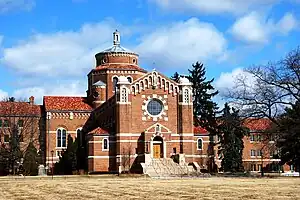 Chapel (1961) of the Felician Sisters in Livonia, Michigan - architectural sculpture by Corrado Parducci.
Chapel (1961) of the Felician Sisters in Livonia, Michigan - architectural sculpture by Corrado Parducci.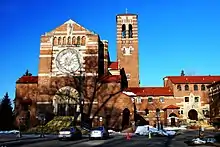 The former Duns Scotus College, once a Franciscan monastery in Southfield, is now the non-denominational Word of Faith.
The former Duns Scotus College, once a Franciscan monastery in Southfield, is now the non-denominational Word of Faith. Former Duns Scotus College in Southfield.
Former Duns Scotus College in Southfield.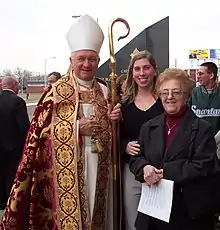 Cardinal Maida outside of the Cathedral of the Most Blessed Sacrament in Detroit
Cardinal Maida outside of the Cathedral of the Most Blessed Sacrament in Detroit
Suffragan sees

See also
Notes
- "Archdiocese of Detroit". Catholic-Hierarchy.org. David M. Cheney. Retrieved October 23, 2018.
- "St. Ignatius Parish". Archdiocese of Detroit. Retrieved January 21, 2011.
- "About the parish". Saint Ignatius Parish. July 17, 2010. Archived from the original on March 5, 2011. Retrieved January 21, 2011.
- "Mission "Sui Iuris" of Cayman Islands". Catholic-Hierarchy.org. David M. Cheney. Retrieved January 21, 2015.
- Woodford, Arthur M. (2001). This is Detroit 1701–2001. Detroit: Wayne State University Press. p. 19. ISBN 978-0-8143-2914-6.
- Poremba, David Lee (2001). Detroit in Its World Setting (timeline). Wayne State University Press. p. 7. ISBN 978-0-8143-2870-5.
- "History". Archdiocese of Detroit. Retrieved March 16, 2016.
- "History". Ss. Peter and Paul Jesuit Church.,
- Austin, Dan. "St. Patrick Catholic Church". Historic Detroit.
- Treppa, Alan R. Rev. John A. Lemke: America's First Native Born Roman Catholic Priest.St. Albertus.org. Retrieved on July 25, 2008. Archived July 7, 2007, at the Wayback Machine
- "Cardinal of Detroit Orders 30 Parishes In the City to Close". The New York Times. Associated Press. January 9, 1989. Retrieved April 24, 2012.
- "Detroit Prelate Backs Plan to Close 43 Churches". Los Angeles Times. October 15, 1988. Retrieved April 24, 2012.
- "County Membership Report: Wayne County, Michigan". Association of Religion Data Archives. 2010.
- Kohn, Joe (May 6, 2011). "Saint Anne declared patroness for Church of Detroit". The Michigan Catholic. Archdiocese of Detroit. Archived from the original on September 3, 2014. Retrieved April 24, 2012.
- Brand-Williams, Orlandar (February 21, 2012). "31 Catholic parishes face consolidation". The Detroit News. Retrieved April 24, 2012.
- Stechschulte, Mike (June 3, 2017). "Archdiocese's new coat of arms a visual reminder of Church's mission". The Michigan Catholic. Retrieved September 30, 2018.
- "Synod16". Archdiocese of Detroit. Retrieved September 30, 2021.
- "Start Here". Unleash the Gospel. Retrieved September 30, 2021.
- "2019 Report on Clerical Sexual Abuse". Archdiocese of Detroit. Archived from the original on October 26, 2020. Retrieved September 30, 2021.
- "Maida, Adam Joseph". Catholic News Agency. Retrieved July 10, 2021.
- Kohn, Joe (February 6, 2009). "Archbishop Vigneron installed as 10th chief shepherd of Detroit diocese". The Michigan Catholic. Retrieved April 24, 2012.
- "Resignations and Appointments" (Press release). Holy See Press Office. May 23, 2022. Retrieved May 23, 2022.
- Stechschulte, Michael (May 23, 2022). "Pope appoints Vatican diplomat Archbishop Russell as Detroit auxiliary bishop". Detroit Catholic. Retrieved May 23, 2022.
- "Pope Francis Appoints Bishop Jeffrey Monforton as Auxiliary Bishop of Detroit; Appoints Bishop Paul Bradley as Apostolic Administrator of Steubenville | USCCB". www.usccb.org. Retrieved September 28, 2023.
- "Region and Vicariate Maps". Archdiocese of Detroit. Retrieved April 15, 2020.
- Montemurri, Patricia (February 1, 2013). "Detroit area's Catholic schools shrink, but tradition endures". Detroit Free Press. Archived from the original on September 13, 2014.
- Haddad, Ken (June 12, 2019). "Marygrove College to close in December after 92 years in Detroit". WDIV News.
References and further reading
- Godzak, Roman (2000). Archdiocese of Detroit (Images of America). Arcadia Publishing. ISBN 978-0-7385-0797-2.
- Godzak, Roman (2004). Catholic Churches of Detroit (Images of America). Arcadia Publishing. ISBN 978-0-7385-3235-6.
- Godzak, Roman (2000). Make Straight the Path: A 300 Year Pilgrimage Archdiocese of Detroit. Editions du Signe. ISBN 978-2-7468-0145-5.
- Hill, Eric J.; Gallagher, John (2003). AIA Detroit: The American Institute of Architects Guide to Detroit Architecture. Wayne State University Press. ISBN 978-0-8143-3120-0.
- Muller, Herman Joseph (1976). The University of Detroit 1877-1977: A Centennial History. University of Detroit. ASIN B0006CVJ4S.
- Tentler, Leslie Woodcock (1992). Seasons of Grace: A History of the Catholic Archdiocese of Detroit. Wayne State University Press. ISBN 978-0-8143-2106-5.
- Tutag, Nola Huse; Hamilton, Lucy (1988). Discovering Stained Glass in Detroit. Wayne State University Press. ISBN 978-0-8143-1875-1.
External links
- Roman Catholic Archdiocese of Detroit official site
- Archdiocese of Detroit Website (aodonline.org) at the Wayback Machine (archive index)
- Archdiocese of Detroit Website (archdioceseofdetroit.org) at the Wayback Machine (archive index)
- Archdiocese of Detroit at http://www.catholic-hierarchy.org
- "Letter from Kerala Catholic Association to Rev. Adam J. Maida, Archbishop of Detroit" in the South Asian American Digital Archive (SAADA)

